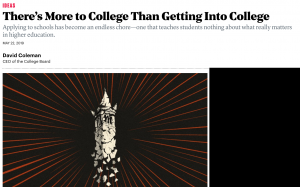Increasing tuition, emerging data on demographics, and the surfacing of admissions scandals casts a long shadow of doubt over the ability of colleges and universities to prepare our students for the future. Couple this with the increasing speed of change in the exponential future, and we as high school educators must be attuned to this change in our already changing landscape.
To help attune ourselves, I recommend the following two articles – to read one after the other in no particular order.
1) Open Letter from the President of Purdue, Mitchell E. Daniels Jr. This was recommended to me by Grant Lichtman, internationally-recognized thought leader on the transformation of K-12 education, so I knew it was worth my time. In it, President Daniels lays out the changing landscape of Purdue, and then asks this questions: Worried yet? 
And the answer for me is “yes”. Daniels’ letter is a provocative use of data to warn us all, not just those at Purdue, of the changing times. He cites that the University of Illinois has taken out a $4.2 million insurance policy against declining enrolment of international students, as the demand for aNorth American education is losing steam – for many reasons like the current White House administration, and growing competition from other post-secondary institutions. He too is worried and supports this with these observations:
As these letters have mentioned before, more and more employers no longer require bachelor’s degrees in their hiring policies. Google, Apple, Ernst & Young, IBM, and Penguin Random House are among them. Apprenticeship and job-specific skills training are attracting increasing attention and favor as alternatives to traditional college diplomas.
Given the questionable curricular rigor at too many colleges today, there is no reason to expect that trend to do anythin
g but grow. It should surprise no one that emerging data is beginning to challenge the standard higher ed retort that “college graduates earn so much more”; that was very true yesterday and across the workforce today, but may not be predictive of the future in which today’s high school Americans will live. One recent study found that more than 20% of recent graduates are “underemployed,” meaning working in jobs not requiring a college diploma, 10 full years after graduating.
So, with this side of the post-secondary future laid out, I then came across a recent article from The Atlantic, called “There’s More to College Than Getting Into College” by David Coleman. In it, he looks at the landscape through the lens of the  user and asks “What kind of education is really worth investing in? What is it that students should be doing, not just to get into college, but to succeed there and live a good life after they graduate?”
user and asks “What kind of education is really worth investing in? What is it that students should be doing, not just to get into college, but to succeed there and live a good life after they graduate?”
To wrap this up, there is a dialogue between these two articles that, when taken together, reflects an increase in rate of change in how college’s and universities are being taken up in our society. From the institutional lens, tuition increases are unsustainable and the product position is shifting in the market. From the user experience, the urgency of a degree is decreasing, and the skills and mindsets to be ‘future-ready’ are no longer owned by colleges and universities. How might high school educators respond to these changes?